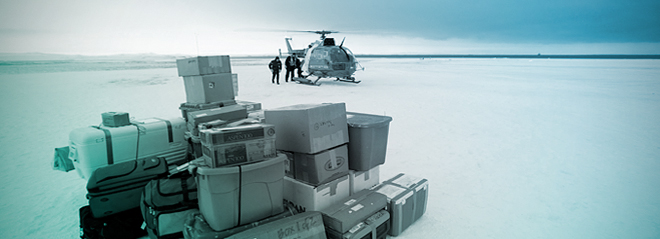To fully understand the impact of climate change and the anthropic pressure on the Arctic ecosystem, the Takuvik program is designed to study both ocean and land ecosystems as well as the interaction between the two components.
|
|

|
|
Land ecosystems/geosystems
Polar environments, including marine (ice cover) and continental (vegetation, lakes) landscapes and ecosystems have been in constant evolution since the Last Glacial Maximum (LGM) and subsequent deglaciation about 20-18 ka ago (e.g. Van Hove et al. 2006). Environmental changes are greatly accelerated under anthropogenic pressure of increased greenhouse gas forcing. Our understanding of modern geosystems and ecosystems, and their projection into the future in response to rapid climate change, is highly dependent on knowledge about how polar and subpolar environments evolved in the past. This paleo-environmental link is the key to the validation of climatic models at regional and global scales. Takuvik projects estimate the kinetics of environmental change at different temporal and spatial scales to better evaluate the effects and consequences of modern climate change on geosystems and ecosystems of the continental Arctic.
The key questions addressed by the Takuvik program are: 1) within the paleoclimate context of the last thousand years, can we identify periods of slow and rapid environmental change, and how may these help interpret the pace and impacts of current warming? 2) what are the directions and magnitudes of feedback processes in the warming continental Arctic? 3) what are the relationships between exploitation of natural resources, environmental consequences and the changing climate?
In order to achieve these goals, we will be developing scientific projects along three main themes: 1- developing and using multi-proxies on sedimentary archives of Holocene environments, 2- studying the effect of modern climate changes on biogeochemical cycles and their retroactions, 3- investigating the impact of anthropogenic activities in northern areas. Chemical and isotopic data, as well as physical properties of organic molecules, sediments, pollens and micro-fossils (e.g. diatoms, chironomids) will be integrated with physical observations to constrain: i- sources of mineral and organic materials in sediments, ii- fluxes between geo-eco-reservoirs, and iii- redox reactions affecting sedimentation, metal enrichments and speciation.
Researchers at ULaval are globally recognized specialists in the study of high latitude environments and have numerous on-going projects within the three defined axes of the Takuvik program. The CNRS researchers and engineers have complementary skills in Earth Sciences, namely organic and mineral geochemistry, isotopic geochemistry, development of proxies, remote sensing and space monitoring. One of the strengths the Takuvik research program is that it will span a broad range of Arctic environments, from low Arctic (subpolar) Nunavik, Quebec, to the northern limit of high Arctic Nunavut. This will be made possible via a unique network of automated climate and weather stations (SILA) equipped with permanent instrumentation (77 stations acquiring climatic and environmental data), and eight field research stations (Qaujisarvik) and base camps created and operated by the Centre d'Études nordiques (CEN), which will be made available to Takuvik researchers. This CEN network is part of the SCANNET circumpolar consortium of observation and research stations. Takuvik will contribute to, and benefit from, the Sustained Arctic Observing Networks which is being developed and implemented by the nations of the Arctic Council. Available equipment at ULaval includes field sediment corers, geophysical instruments, boats and all-terrain-vehicles as well as laboratories for sample storage, treatment and preparation before analysis (radiochronology, paleoecology, paleolimnology, sedimentology). Chemical and isotopic analyses will be done at the INSU National Facilities (including SARM and Ion Probe in Nancy, MC-ICP-MS in ENS-Lyon). Furthermore, as an associate member of GEOTOP (réseau stratégique inter-universitaire, with many collaborative links with CEN),Takuvik will have access to the instrumental infrastructure of the GEOTOP research center in Montréal, including mass spectrometers and clean rooms.





